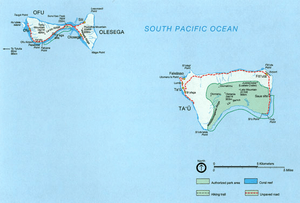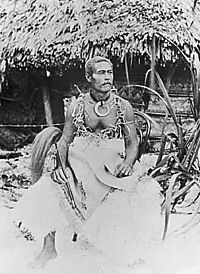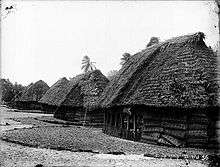Manuʻa Islands
The Manuʻa Islands,[1][2][3] or the Manuʻa tele (Samoan: Manuʻa tele), in the Samoan Islands, consists of three main islands: Taʻū, Ofu and Olosega.[4][5][6] The latter two are now connected by a bridge over the shallow 137-meter-wide Āsaga Strait. The islands are located some 110 kilometers (68 miles) east of Tutuila and are a part of American Samoa, an unincorporated territory of the United States; their area is 56 square kilometers (22 square miles) with a population of 1,400. Taʻu is the biggest island with its 44 km2 (17 sq mi), and harbors the highest point of the Manuʻa at 931 meters (3,054 feet). Politically, the islands form the Manuʻa District, one of the three administrative divisions of American Samoa.

For centuries, Manu'a was the political centre for the region prior to the rise of the Tu'i Tonga maritime empire and the shift in power from the east to the western islands of Samoa.
Geography

All three islands are high islands: volcanic remnants rising out of the sea 14° south of the equator. The islands are elevated and mountainous.[7] In contrast to most places in the world, the population of these islands has been decreasing steadily for decades. In the 1930s some 20% of the population of American Samoa lived in the Manuʻa Islands. By the 1980s, only 6% were located there. Emigration is the consequence of a lack of economic opportunities and a desire of young people to participate in the more modern lifestyle offered on Tutuila (Office of Tourism, 2005). All the land of Manuʻa is owned communally by Samoan families of Manuʻa. This includes the National Parks lands which are only leased to the US National Parks system for 50 years.
History
Samoan oral historical traditions state that Manu'a was a ruling center of a large Polynesian empire which included all of the Samoan archipelago, and other nearby islands such as Tonga and Fiji.[8] The traditional capital of Manuʻa is the village of Taʻū, on the island of Taʻū.
The Tui Manu'a
The sovereign of Manuʻa was called the Tui Manuʻa, the progenitor of many of Samoa's high titles and the only part of Samoa that was not subjected to Tongan rule, owing to its sacred status to both cultures. The last Tui Manuʻa was Tuimanuʻa Elisara (or Tui Manuʻa Elisala) of the early 20th century. Tuimanuʻa Elisara died on July 2, 1909. The title Tui Manuʻa technically still exists although there is no titleholder; Tuimanuʻa Elisara desired before his death that the title die with him. It was the U.S. government position at the time that his title changed to District Governor upon the hoisting of the U.S. flag at Taʻū on June 5, 1900 (Office of the Governor. 2004). However, titles and holdings were not obliterated when the islands became a U.S. territory, and the title and estates of Tuimanuʻa remain under the custody of the Anoalo clan (male side of the Tuimanuʻa line).
These are the known Tui Manu'a: 41 successive generations of title holders spanning over 2,000 years. Note: these aren't all the title holders.
01) Tui Manu’a Satiailemoa
02) Tui Manu’a Tele or Fitiaumua
03) Tui Manu’a Maugaotele
04) Tui Manu’a Tae O Tagaloa or Folasa
05) Tui Manu’a Fa’aeanu’u or Fa’atutupunu’u
06) Tui Manu’a Saoioiomanu
07) Tui Manu’a Saopu’u
08) Tui Manu’a Saoloa
09) Tui Manu’a Tu’ufesoa
10) Tui Manu’a Letupua
11) Tui Manu’a Saofolau
12) Tui Manu’a Saoluaga
13) Tui Manu’a Lelologatele
14) Tui Manu’a Alia Matua
15) Tui Manu’a Alia Tama
16) Tui Manu’a Ti’aligo
17) Tui Manu’a Fa’aeanu’u II
18) Tui Manu’a Puipuipo
19) Tui Manu’a Siliaivao
20) Tui Manu’a Manufili
21) Tui Manu’a Fa’atoalia Manu-O-Le-Fale-Tolu
22) Tui Manu’a Segisegi
23) Tui Manu’a Siliave
24) Tui Manu’a Pomelea
25) Tui Manu’a Lite or Tui Aitu
26) Tui Manu’a Toalepa’i
27) Tui Manu’a Seuea
28) Tui Manu’a Salofi
29) Tui Manu’a Levaomana or Lemamana
30) Tui Manu’a Taliutafa Pule
31) Tui Manu’a Ta’alolomanu Moaatoa
32) Tui Manu’a Tupalo
33) Tui Manu’a Seiuli
34) Tui Manu’a U’uolelaoa
35) Tui Manu’a Fagaese
36) Tui Manu’a Tauveve
37) Tui Manu’a Tauilima
38) Tui Manu’a Alalamua
39) Tui Manu’a Makerita
40) Tui Manu’a Elisala – Officially the last Tui Manu’a who died in 1909
41) Tui Manu’a Kilisi Taliutafa – Revived the Tui Manu’a title in 1924 but never fully took office.

US Cession

The Manuʻa Group is now part of the US Protectorate of American Samoa. Following Tutuila's signing in 1901, Manu'a was eventually forced to accept U.S. rule in a Deed of Succession, signed by the Tui Manuʻa (supreme chief of Manuʻa) on July 16, 1904 at the Crown residence of the Tuimanuʻa called the Faleula in the place called Lalopua (from Official documents of the Tuimanuʻa government, 1893; Office of the Governor, 2004). Cession followed the Tripartite Convention of 1899 that partitioned the eastern islands of Samoa (including Tutuila and the Manuʻa Group) from the western islands of Samoa (including ʻUpolu and Savaiʻi).
In 1903, Manu'a had a total population of approximately 2,000 residents.[9] The Manu'a Hurricane of 1915 is particularly notable of two reasons. It was the first time the U.S. Congress voted to send financial aid to American Samoa, and it was the first time the American Red Cross made a donation to American Samoa.[10]
Society and culture

The history of Manuʻa is said in Samoan oratory to contain the origins of Samoan and Polynesian culture, and the genealogy of Polynesians east of Samoa is said to have originated in Manuʻa. In traditional belief the sun rises over Samoa at Saua on the island of Taʻū, where the coral reef is supposed to be always yellow from the sun, and it sets at Falealupo the western-most village on the island of Savaiʻi in Samoa. This journey of the sun is strongly related to traditional beliefs and defines the uniformity of cultural identity across both Samoas. The term Fa'asamoa describes "The Samoan Way", or traditional Samoan way of life
Economy
Today, many families of Manuʻa rely on income from family members working in Tutuila and in the United States. The local diet is generally healthier than in Tutuila, with less reliance on imported American and New Zealand tinned foods, and a greater reliance on local fishing and farming.
Language
The people of Manuʻa speak the Samoan language and utilize the "t".
Education
The high school on Taʻū, called Manuʻa High School, serves all of Manuʻa. Most students seeking higher education go to American Samoa Community College in Tutuila or National University of Samoa on ʻUpolu, or as far away as the University of Hawaiʻi and elsewhere.
References
- https://www.britannica.com/place/Manua-Islands Britannica.com. Manua Islands. Retrieved July 4, 2020.
- https://www.nps.gov/npsa/learn/historyculture/nameeson-land.htm U.S. National Park Service. National Park of American Samoa. Names Upon the Land. Retrieved July 4, 2020.
- https://www.lonelyplanet.com/american-samoa/manua-islands Lonely Planet. Manu'a Islands. Retrieved July 4, 2020.
- Hills, J.W. (2010). O upu muamua i le Tala i le Lalolagi mo e ua faatoa aʻoaʻoina u lea mataupu: Elementary Geography. Nabu Press. Page 62. ISBN 9781147952896.
- Gupta, Alok K. (1998). Igneous Rocks. Allied Publishers. Page 382. ISBN 9788170237846.
- Shaffer, Robert J. (2000). American Samoa: 100 Years Under the United States Flag. Island Heritage. Page 210. ISBN 9780896103399.
- Hills, J.W. (2010). O upu muamua i le Tala i le Lalolagi mo e ua faatoa a'oa'oina u lea mataupu: Elementary Geography. Nabu Press. Page 62. ISBN 9781147952896.
- "Journal of the Polynesian Society: An Experiment In Tongan History, By E. E. V. Collocott, P 166-184". jps.auckland.ac.nz.
- Hills, J.W. (2010). O upu muamua i le Tala i le Lalolagi mo e ua faatoa a'oa'oina u lea mataupu: Elementary Geography. Nabu Press. Page 64. ISBN 9781147952896.
- Shaffer, Robert J. (2000). American Samoa: 100 Years Under the United States Flag. Island Heritage. Page 145. ISBN 9780896103399.
- McMullin, Dan. 2005. "The Passive Resistance of Samoans to US and Other Colonialisms", article in Sovereignty Matters , University of Nebraska Press.
- Office of the Governor. 2004. Manuʻa ma Amerika. A brief historical documentary. Manuʻa Centennial. 16 July 1904. 16 July 2004. Office of the Governor, American Samoa Government. 20 p.
- Office of Tourism. 2005. The Manuʻa Islands. Office of Tourism, Dept. of Commerce, Government of American Samoa (pamphlet).
External links
| Wikimedia Commons has media related to Manua Islands. |